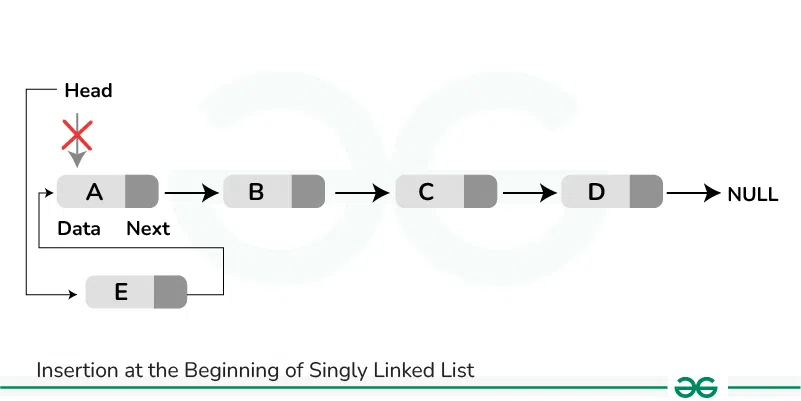Insert a Node at Front/Beginning of a Linked List
Last Updated :
22 Feb, 2024
Given a linked list, the task is to insert a new node at the beginning/start/front of the linked list.

Example:
Input: LinkedList = 2->3->4->5, NewNode = 1
Output: LinkedList = 1->2->3->4->5
Input: LinkedList = , NewNode = 1
Output: LinkedList = 1
Approach:
To insert a node at the start/beginning/front of a Linked List, we need to:
- Make the first node of Linked List linked to the new node
- Remove the head from the original first node of Linked List
- Make the new node as the Head of the Linked List.
The below steps should be followed to insert a new node at the front of the linked list
- Allocate a new node (say temp).
- Put the required data into temp.
- The ‘next’ pointer of the node should be pointed to the current head.
- Now make the head pointer point to temp.
Below is the implementation of the approach:
C++
#include <bits/stdc++.h>
using namespace std;
class Node {
public:
int data;
Node* next;
};
void insertAtFront(Node** head_ref, int new_data)
{
Node* new_node = new Node();
new_node->data = new_data;
new_node->next = (*head_ref);
(*head_ref) = new_node;
}
void printList(Node* node)
{
while (node != NULL) {
cout << " " << node->data;
node = node->next;
}
cout << "\n";
}
int main()
{
Node* head = NULL;
insertAtFront(&head, 1);
insertAtFront(&head, 2);
insertAtFront(&head, 3);
insertAtFront(&head, 4);
insertAtFront(&head, 5);
insertAtFront(&head, 6);
cout << "After inserting Nodes at their front: ";
printList(head);
return 0;
}
|
C
#include <stdio.h>
#include <stdlib.h>
struct Node {
int data;
struct Node* next;
};
void insertAtFront(struct Node** head_ref, int new_data)
{
struct Node* new_node
= (struct Node*)malloc(sizeof(struct Node));
new_node->data = new_data;
new_node->next = (*head_ref);
(*head_ref) = new_node;
}
void printList(struct Node* node)
{
while (node != NULL) {
printf(" %d", node->data);
node = node->next;
}
printf("\n");
}
int main()
{
struct Node* head = NULL;
insertAtFront(&head, 1);
insertAtFront(&head, 2);
insertAtFront(&head, 3);
insertAtFront(&head, 4);
insertAtFront(&head, 5);
insertAtFront(&head, 6);
printf("After inserting nodes at their front: ");
printList(head);
return 0;
}
|
Java
import java.io.*;
class Node {
int data;
Node next;
}
class LinkedList {
Node head;
void insertAtFront(int new_data)
{
Node new_node = new Node();
new_node.data = new_data;
new_node.next = head;
head = new_node;
}
void printList()
{
Node node = head;
while (node != null) {
System.out.print(node.data + " ");
node = node.next;
}
System.out.println();
}
public static void main(String[] args)
{
LinkedList list = new LinkedList();
list.insertAtFront(6);
list.insertAtFront(5);
list.insertAtFront(4);
list.insertAtFront(3);
list.insertAtFront(2);
list.insertAtFront(1);
System.out.print(
"After inserting nodes at their front: ");
list.printList();
}
}
|
Python3
class Node:
def __init__(self):
self.data = None
self.next = None
def insertAtFront(head_ref, new_data):
new_node = Node()
new_node.data = new_data
new_node.next = head_ref
head_ref = new_node
return head_ref
def printList(node):
while (node != None):
print(node.data, end=" ")
node = node.next
print("\n")
if __name__ == '__main__':
head = None
head = insertAtFront(head, 6)
head = insertAtFront(head, 5)
head = insertAtFront(head, 4)
head = insertAtFront(head, 3)
head = insertAtFront(head, 2)
head = insertAtFront(head, 1)
print("After inserting nodes at thier front: ", end="")
printList(head)
|
C#
using System;
class GFG {
public Node head;
public class Node {
public int data;
public Node next;
public Node(int d)
{
data = d;
next = null;
}
}
public void insertAtFront(int new_data)
{
Node new_node = new Node(new_data);
new_node.next = head;
head = new_node;
}
public void printList()
{
Node tnode = head;
while (tnode != null) {
Console.Write(tnode.data + " ");
tnode = tnode.next;
}
Console.WriteLine();
}
public static void Main(String[] args)
{
GFG llist = new GFG();
llist.insertAtFront(6);
llist.insertAtFront(5);
llist.insertAtFront(4);
llist.insertAtFront(3);
llist.insertAtFront(2);
llist.insertAtFront(1);
Console.Write("After inserting nodes at their front: ");
llist.printList();
}
}
|
Javascript
class Node {
constructor(data) {
this.data = data;
this.next = null;
}
}
function insertAtFront(head_ref, new_data) {
const new_node = new Node(new_data);
new_node.next = head_ref[0];
head_ref[0] = new_node;
}
function printList(node) {
let current = node;
while (current !== null) {
console.log(" " + current.data);
current = current.next;
}
console.log("\n");
}
function main() {
const head = [null];
insertAtFront(head, 1);
insertAtFront(head, 2);
insertAtFront(head, 3);
insertAtFront(head, 4);
insertAtFront(head, 5);
insertAtFront(head, 6);
console.log("After inserting Nodes at their front:");
printList(head[0]);
}
main();
|
Output
Created Linked list is: 2 3 4 5 6
After inserting 1 at front: 1 2 3 4 5 6
Explanation: In the above code we have inserted nodes before them and each node is inserted before the already inserted nodes.
Time Complexity: O(1)
Auxiliary Space: O(1)
Share your thoughts in the comments
Please Login to comment...